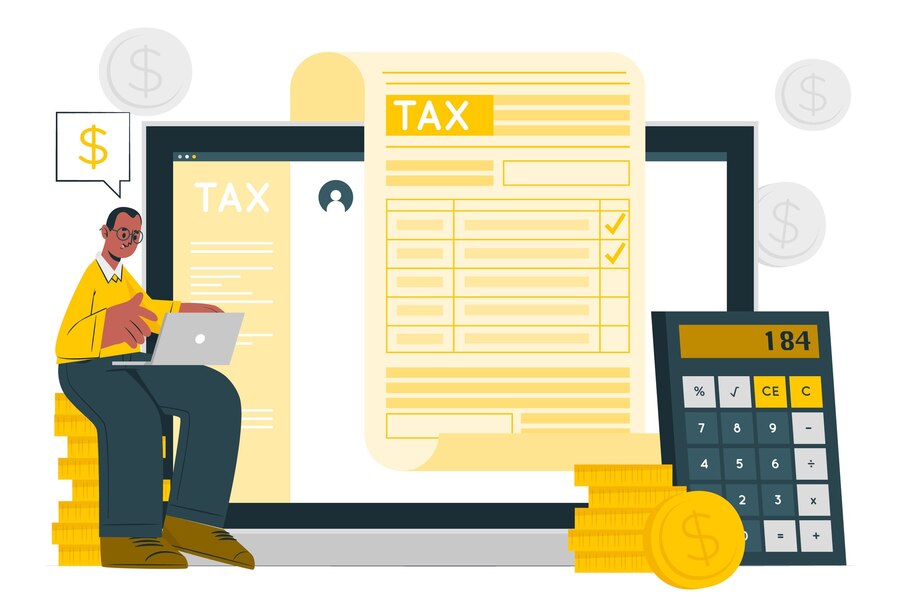Step-by-Step Guide to Download ASMT 11 GST in Word Format
- 15 Aug 24
- 14 mins

Step-by-Step Guide to Download ASMT 11 GST in Word Format
Key Takeaways
- Utilize Microsoft Word to create editable and easily manageable ASMT-11 forms.
- Develop a template in Word for consistent and efficient ASMT-11 submissions.
- Convert ASMT-11 forms to PDF to preserve formatting and ensure accuracy before submission.
- Keep digital backups of completed ASMT-11 forms for easy access and audit readiness.
- Leverage Word’s version control capabilities to track changes and updates to ASMT-11 documents.
Goods and Services Tax (GST) is a comprehensive, multi-stage tax on goods and services, implemented to consolidate multiple indirect tax levies into a single tax. This reform aims to create a single national market and boost economic growth.
Types of GST
The main objective of GST is to consolidate multiple indirect tax levies into a single tax, aiming to create a single national market and reduce tax complexities. Here are the primary types of GST as implemented in countries like India:
- Central Goods and Services Tax (CGST)
Administered by: The Central Government
Collected on: Transactions of goods and services within a single state.
The central government shares in the CGST revenue.
- State Goods and Services Tax (SGST)
Administered by: State Governments
Collected on: Transactions within a single state.
SGST's revenue goes to the state where the goods or services are consumed.
Integrated Goods and Services Tax (IGST)
Administered by: Central Government
Collected on: Interstate transactions and imports.
The IGST ensures that the state where the goods or services are consumed gets its share of the tax revenue.
- Union Territory Goods and Services Tax (UTGST)
Administered by: Union Territory governments
Collected on: Transactions within a Union Territory without a legislature.
It is similar to SGST and applies to territories like Chandigarh and Lakshadweep.
- Special Types of GST
Compensation Cess: Some goods and services attract a compensation cess in addition to CGST and SGST/UTGST. This cess is levied to compensate states that may lose revenue under the GST regime, particularly during the initial years of GST implementation.
Importance of Managing GST Compliance

Managing Goods and Services Tax (GST) compliance is crucial for several reasons, particularly for businesses that operate in regions where GST is applicable, such as India. Effective GST compliance involves timely and accurate filing of tax returns, proper invoicing, and adherence to all regulatory requirements.
The ASMT-11 form is a critical document in this process, facilitating communication between tax authorities and businesses regarding discrepancies or additional information required for GST filings.
Here are some key reasons why managing GST compliance is important:
- Avoidance of Penalties and Legal Consequences
Failing to comply with GST regulations can lead to hefty fines, penalties, and even legal action. Regular and accurate compliance helps avoid these punitive measures, ensuring that a business operates smoothly without interruptions.
- Enhanced Credibility
Businesses that consistently meet GST compliance standards are often seen as more credible and trustworthy. This perception is beneficial for maintaining good relationships with stakeholders, including investors, customers, and suppliers.
- Seamless Claiming of Input Tax Credit (ITC)
Proper management of GST allows businesses to accurately claim input tax credits. This is the credit businesses receive for the tax paid on input goods and services that can be offset against the GST payable on output. Accurate and timely filing is essential to maximizing these claims, which can significantly reduce overall tax liability.
- Efficient Cash Flow Management
By adhering to GST regulations and timelines, businesses can better manage their cash flows. Knowing when tax payments are due helps in planning expenses and investments more effectively, avoiding unexpected financial burdens.
- Reduction in Tax-Related Errors
Effective GST management involves keeping detailed records and adopting systematic processes. This reduces the likelihood of errors in tax calculations and filings, which can otherwise lead to complications with tax authorities.
- Facilitation of Compliance Audits
GST audits by tax authorities are smoother when a business has a clean and compliant GST filing record. Well-maintained records and compliance help expedite the audit process and reduce the chances of any discrepancies being found.
- Better Decision-Making
When businesses maintain comprehensive compliance, they have a clearer view of their tax obligations and financial standing. This information is crucial for making informed strategic decisions, such as pricing, budgeting, and financial planning.
- Keeping up with Regulatory Changes
GST laws and regulations may change frequently, and staying compliant means keeping up with these changes. Regularly updating compliance practices as per the latest guidelines helps businesses adapt to new tax environments without disruption.
- Building a Strong Reputation
Consistent compliance with GST not only avoids negative legal implications but also builds a positive reputation for the business in the marketplace. This can be beneficial for attracting new customers and expanding the business.
What is ASMT-11 in GST?
ASMT-11 is a specific form associated with the Goods and Services Tax (GST) system in India. It plays a critical role in the administrative framework of GST compliance. ASMT-11 is essentially a notice or a form issued by the tax authorities to a GST registrant. It serves the purpose of seeking additional information or clarification regarding discrepancies or anomalies noticed by the tax authorities during the scrutiny of GST returns filed by taxpayers.

Key Features of ASMT-11
- Purpose
The primary purpose of ASMT-11 is to notify taxpayers about discrepancies in their submitted GST data that need clarification or rectification. It helps in maintaining transparency and accuracy in the GST filings and ensures that the correct amount of tax is collected and reported.
- Issuance
ASMT-11 is issued when there is a mismatch or an anomaly in the GST returns that cannot be resolved through automated matching processes. This could be due to discrepancies in the input tax credit claims, tax payment details, or inconsistencies in sales and purchase invoices.
- Response Requirement
Upon receiving an ASMT-11, taxpayers are required to respond within a specified timeframe, typically 30 days from the date of receipt of the notice. The response must include a satisfactory explanation or the necessary documents to clarify the issues raised.
- Consequences of Non-Compliance
Failure to respond to ASMT-11 notices can lead to adverse actions, including denial of disputed input tax credits, imposition of fines, or even a detailed audit. It’s essential for businesses to address these notices promptly to avoid penalties and potential legal challenges.
- Rectification and Adjustment
If the taxpayer agrees with the discrepancy noted in ASMT-11, they must rectify the error in their subsequent GST filings. If the taxpayer disagrees, they must provide adequate evidence and documentation to support their stance.
Detailed Breakdown of ASMT-11 Form
The ASMT-11 form is an integral part of the GST compliance mechanism used in India. It functions as a formal communication tool from the tax authorities to the taxpayers, specifically addressing any discrepancies identified during the processing of GST returns. Here’s a detailed breakdown of the various components and sections of the ASMT-11 form:
Sections of the ASMT-11 Form
- Header Information
This section includes basic details such as the form name (ASMT-11), the unique reference number of the notice, and the date of issue.
- Taxpayer Details
GSTIN: Goods and Services Tax Identification Number of the taxpayer.
Legal Name and Trade Name: As registered under GST.
These details help in identifying the taxpayer and ensuring that the notice is directed to the correct entity.
- Details of Discrepancy
This is the core section of the form where the specific discrepancies identified in the taxpayer's submissions are detailed. It may include discrepancies related to input tax credits, mismatched sales or purchase details, or any other irregularities that need clarification.
Each discrepancy is usually listed with a reference to the specific part of the GST returns where it was identified.
- Action Required by Taxpayer
This section outlines what the taxpayer needs to do in response to the notice. It typically requires the taxpayer to either:
Provide additional documentation or explanation to justify the entries.
Amend the returns to correct the discrepancies.
The form will specify the exact details of the response expected, whether it is documentary evidence, a written explanation, or corrected data submissions.
- Deadline for Compliance
The date by which the taxpayer must comply with the request for information or correction is clearly stated. This is crucial, as failing to respond within the deadline can lead to penalties or further legal proceedings.
- Declaration and signature
A section for the taxpayer to declare that the information provided in response is true and accurate to the best of their knowledge.
The authorized signatory of the business must sign the form.
Step-by-Step Guide to Filling Out ASMT-11
Filling out the ASMT-11 form correctly is crucial for addressing discrepancies identified by the GST authorities in India. Here is a step-by-step guide to help you complete the ASMT-11 form effectively:
Step 1: Review the Notice Carefully?feature=shared
- Understand the Discrepancy: Begin by thoroughly reading the ASMT-11 notice to understand the specific discrepancies or issues raised by the GST authorities.
- Gather Relevant Information: Collect all relevant documents and records that relate to the discrepancy mentioned in the notice. This could include invoices, GST returns, and other supporting documentation.
Step 2: Collect Required Documentation
- Documentation: Depending on the nature of the discrepancy, gather documents such as purchase and sales invoices, bank statements, ledgers, and previous GST returns. These documents should correspond to the periods and transactions questioned in the ASMT-11.
Step 3: Prepare Your Response
- Clarifications and Corrections: Prepare a detailed response that addresses each point raised in the notice. If corrections are required, ensure that you understand how to amend the previously filed returns.
- Written Explanations: For some discrepancies, a written explanation may suffice. Be clear and concise in your explanations, providing factual and direct answers to the issues raised.
Step 4: Fill Out the Form
- Taxpayer Details: Enter your GSTIN, legal name, and trade name as registered in your GST profile.
- Details of Discrepancy and Response: For each discrepancy listed in the ASMT-11, provide your response. If additional sheets are needed, attach them properly.
- Declaration: Check the declarations box to confirm that the information provided is true and correct to the best of your knowledge.
- Signature: Sign the form. The individual taxpayer or the company's authorized signatory must sign the form.
Step 5: Submit the Form
- Submission Method: Determine whether the form needs to be submitted electronically or in hard copy. The notice will typically specify the mode of submission.
- Deadline: Ensure that you submit the form and any accompanying documentation before the deadline specified in the ASMT-11 notice to avoid penalties.
Step 6: Keep Records
- Record Keeping: Keep copies of the ASMT-11 form, your response, and all correspondence with the GST authorities. These documents may be necessary for future references or in case of disputes.
Step 7: Follow Up
- Monitor for Further Communication: After submitting your response, keep an eye on any further communications from the GST authorities. They may accept your explanation and corrections, request additional information, or issue another form if discrepancies continue to persist
Using Word Format for ASMT-11

Using Microsoft Word format for preparing and managing your ASMT-11 responses can be advantageous for several reasons. Microsoft Word is a versatile tool that offers easy editing, formatting, and storage capabilities, making it suitable for handling official documents like ASMT-11.
Here’s how you can effectively use Word format for your ASMT-11 form:
Benefits of Using Word Format for ASMT-11
- Editability: Word documents are easy to edit and update, which is essential when dealing with documents that require frequent modifications based on additional information or corrections.
- Accessibility: Most people are familiar with Microsoft Word, making it accessible for individuals handling GST compliance without needing specialized software training.
- Template Usage: You can create templates for the ASMT-11 form in Word, which can be reused for similar notices in the future, ensuring consistency and saving time.
- Integration: Word documents can be easily integrated with other office management tools and systems, facilitating a smoother workflow.
- Version Control: Word allows for versioning if the document is saved on platforms that support this feature (like SharePoint or OneDrive), which means you can track changes over time and revert to previous versions if necessary.
Step-by-Step Guide to Using Word for ASMT-11
Step 1: Create a New Document
Start by opening Microsoft Word and creating a new document. If you have a template for ASMT-11, open the template instead.
Step 2: Set Up the Document Layout
Format your document to ensure it looks professional and is easy to read. Set appropriate margins, choose a readable font (like Times New Roman or Arial), and set a suitable font size (typically 12 pt).
Step 3: Input the Form Fields
- Header: Include the form name (ASMT-11), the reference number, and the date of issue at the top.
- Taxpayer Details: Insert fields for GSTIN, legal name, and trade name.
- Details of Discrepancy: Clearly describe each discrepancy that the GST authorities have identified using a table or a list format.
- Response Section: Provide a designated area or table where responses to each discrepancy can be entered.
- Documentation: Include a section where details of attached documents can be listed.
Step 4: Input Content
Fill in each section with the relevant information, responding to the discrepancies as required. Use bullet points or numbered lists for clarity.
Step 5: Review and Edit
Once all the information is in place, thoroughly review the document for any errors or omissions. Make use of Word’s spell and grammar check tools.
Step 6: Convert to PDF (Optional but Recommended)
Once the document is finalized and reviewed, convert it to PDF format before submission. This step ensures that the formatting remains intact when viewed on different devices and platforms.
Step 7: Save and Backup
Save the final document in both Word and PDF formats. Keep backups in a secure location for future reference or in case of audits.
Step 8: Submission
Follow the GST authorities' instructions regarding the required submission process, which may involve sending a physical copy or uploading the document electronically.
Importance of ASMT-11 in GST Compliance
ASMT-11 is an integral part of the GST compliance framework, facilitating interaction between taxpayers and tax authorities to ensure accurate tax reporting. By addressing the discrepancies noted in ASMT-11, taxpayers contribute to the overall efficiency and effectiveness of the GST system, ensuring that tax liabilities are calculated correctly and government revenues are protected. For businesses, responding accurately and promptly to ASMT-11 notices is crucial to maintaining compliance and avoiding financial penalties.
Conclusion
Businesses subject to the GST system must manage their compliance effectively. Knowing forms like ASMT-11, as well as using technological solutions like GST software and cloud platforms, helps to expedite the compliance process and ensure accuracy and efficiency.
These solutions not only ease tax management, but they also improve a company's financial and legal status. It is critical to stay current with GST legislation and react as it changes. Finally, integrating strategic planning with new technology is critical to ensuring effective and long-term GST compliance.
💡Facing issues with timely GST payments? Consider using Pice business payment app and paying your GST with a credit card at a low cost to enjoy extended payment terms and improve cash flow.




















